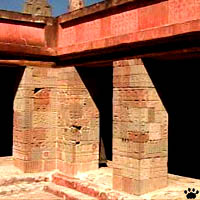
Palacio de Quetzalpapalotl (Palace of Quetzal Butterfly), Teotihuacan.
Driving through Mexico - Part 3
If you are a US citizen, all you need to drive through Mexico
is a passport, car registration and title, a credit card, and some cash. If you'd
like to continue further south, take some extra cash for bribes if going through
Belize (where the police is more corrupt than anywhere in the Americas). Take
also a bag to conceal your video camera, otherwise you'll have to pay "camera
fees" in museums, caves and numerous ancient cities,
built over centuries by many civilizations.
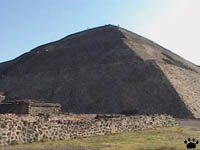
Piramide del Sol, Teotihucan. |
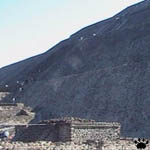
Climbing Piramide del Sol. |
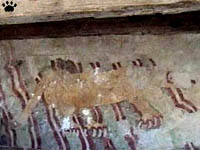
Puma mural, Teotihuacan. |

Piramide de la Luna, Teotihuacan. |
The most impressive and mysterious of them all,
Teotihuacan (appr. AD 1-700), is also the most accessible one: it is just outside
Mexico City. Try to visit it early in the morning to avoid the heat and the crowds. |
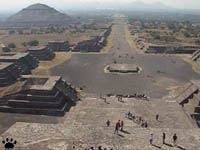
View from the top of Piramide de la Luna. |
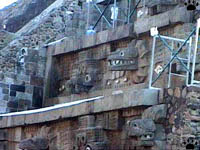
Templo de Quetzalcoatl, Teotihuacan. |
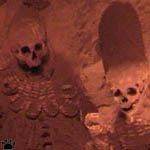
Burial, Teotihuacan. |
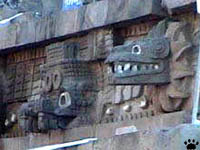
Detail of Templo de Quetzalcoatl. |
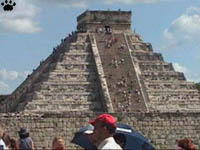
El Castillo, Chichen Itza. There is an older
pyramid inside it, accessible via a tunnel. |
The same applies to major Mayan cities, particularly
Chichen Itza (mostly AD 700-1400) on Yucatan Peninsula, which is usually overrun
by countless busloads of tourists from the nearby resort megapolis, Cancun. |
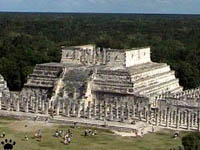
View of Templo de los Guerreros and
Mil Columnas from the top of El Castillo. |
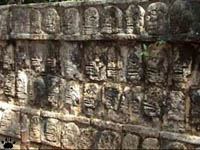
Platforma de los Craneos, Chichen Itza. |
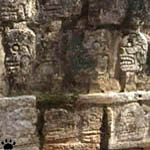
Detail, Platforma de los Craneos. |
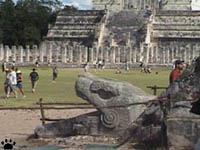
Head of a giant snake, Chichen Itza. |
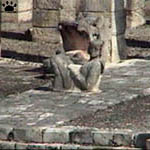
Detail, Templo de los Guerreros. |
Chichen Itza is full of fascinating things: pyramids
serving as calendars, an ancient observatory, temples built on top of one another,
sacred cenote (sinkhole lake) once used for human sacrifices,
illusory snake visible on a side of El Castillo during equinox, a huge ball court,
where ritual ball games ended with losers being sacrificed and partly eaten by
winners, and so on. |
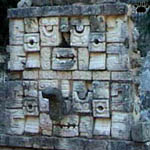
Lego-style masks, Chichen Itza. |
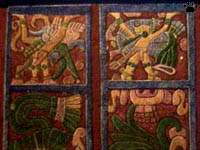 |
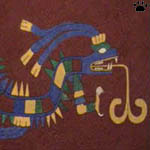 |
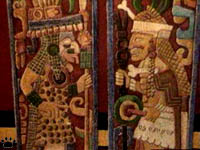 |
| Ancient Mayan cities
were once very colorful. These are restored frescoes and reliefs from Chichen
Itza museum. |

Templo de la Cruz (left) & El Palacio, Palenque. |
Another outstandingly beautiful Mayan city is
Palenque (100 BC-AD 900, but mostly AD 600-700) in Chiapas. Its highlights include
a labyrynthine palace, numerous inscriptions, and a unique tower. |
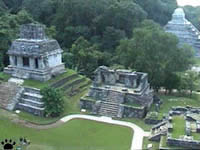
Grupo Norte, Palenque. |

Historical inscription, Palenque. |
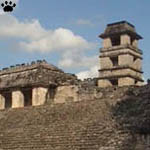
Palace tower, Palenque. |
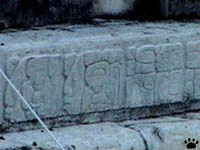
Calendar inscription, Palenque. |

Templo de las Inscripciones, Palenque. |
Palenque also has a lot of interesting plants
and animals in ajacent hill rainforest (walk upstream the creek, beyond "area
closed" signs), and some bats in buildings (look in rooms marked "no
entrance"). |
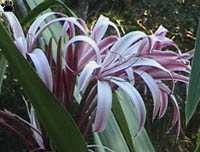
Flowers, Palenque. |

Jaguar and harpy eagle, Palenque. |
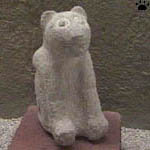
Cat, Palenque museum. |
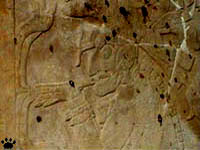
Portrait of rain god, Palenque. |
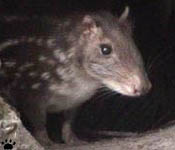
Paca (Agouti paca), Hormiguero. |
Small, remote ruins are best visited in moonlit
nights, when they are deserted, the guards are absent or asleep, and the streets
are full of wildlife. Of the places I've visited, Hormiguero in Campeche had the
most interesting fauna, including a margay cat. |

Kinkajou (Potos flavus), Hormiguero. |
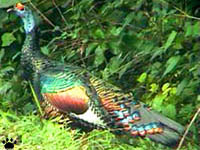
Ocellated turkey (Meleagris ocellata), Tikal. |
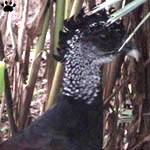
Great curassow (Crax rubra), Tikal. |
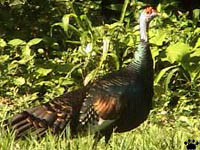
Ocellated turkey, Tikal. |
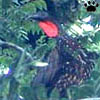
Crested guan (Penelope
purpurascens), unnamed
Mayan site, Campeche. |
Most ancient cities are also good for birdwatching.
Tikal in Guatemala, for example, is the best place
to see rare, shy species of large wildfowl that has been hunted almost to extinction
in most other areas. Even Teotihuacan with its broad streets and little vegetation
has some interesting wildlife: pocket gophers, ground and tree squirrels, and
many birds, especially in the vicinity of the main museum. |
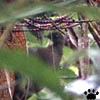
Plain chachalaca
(Ortalis vetula),
Palenque, Chiapas. |
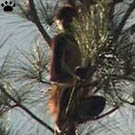
Spider monkey (Ateles geoffroyi),
Tolun, Quintana Roo. |
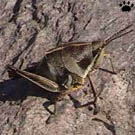
Tetrix catydid,
Teotihuacan. |
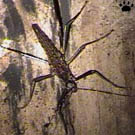
Colonial walkingstick,
Hormiguero |
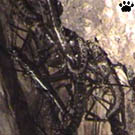
Colonial walkingsticks,
Hormiguero |
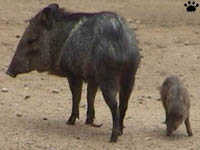
Collared peccaries (Tayassu tajacu), LVP. |
Surprisingly, La Venta Park, an archaeological
museum in the middle of a huge city called Villahermosa in Tabasco, also has lots
of wild animals, from coatis, raccoons, agoutis,
and squirrels to peccaries, armadillos, and howler monkeys (784
Kb Mpg. video). |

Collared peccaries, La Venta Park. |
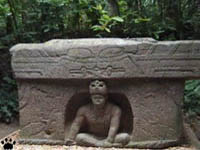
Altar Triunfal, La Venta Park. |
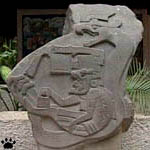
Snake god, La Venta Park. |
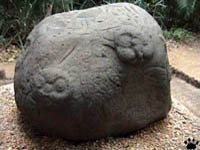
Owls, La Venta Park.. |
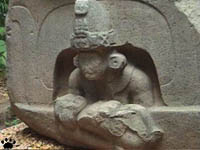
Altar de los Ninos, La Venta Park. |
La Venta (100-600 BC), the capital of Olmecs,
the first Mesoamerican civilization, was mostly destroyed during the oil boom
of the early 20th century, but its wonderful sculptures have been moved to the
Park. |
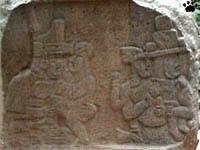
Children sacrifice, Altar de los Ninos. |
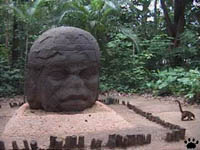
"Olmec head" and a coati, La Venta Park. |
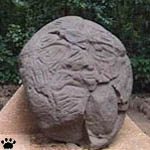
Unfinished head, La Venta Park. |

"Olmec head" and a camcoder case, La Venta Park. |
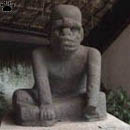
El Guerrero, La Venta Park. |
Most archaeologists say that Olmec sculptures
such as the famous colossal "Olmec heads" are not a proof of
some ancient African contact. Being usually a skeptic, I still find it very difficult
to believe. Just look at them. They are strikingly different from all other depictions
of human face in pre-Columbian art, aren't they? |

El Mono, La Venta Park. |
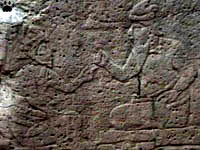
This is usually said to be a depiction of a dialogue,
but I think it is "rock, paper, scissors" game. |
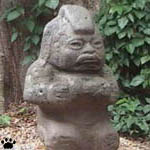
La Abuela (Grandmother),
La Venta Park. |

Unidentified flowers,
La Venta Park. |
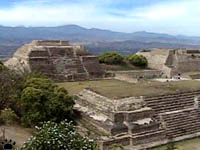
Monte Alban, Oaxaca. |
Among other interesting ancient cities are Monte
Alban (200 BC - AD 700), a Zapotec capital on a hilltop above Oaxaca City, and
El Tajin (AD 200-1000), the capital of little-known Classic Veracruz civilization. |
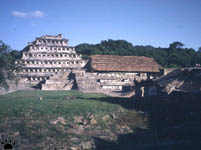
El Tajin, Veracruz. |
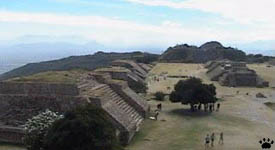
View of Gran Plaza, Monte Alban. |
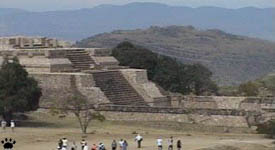
Platforma Sur, Monte Alban. |
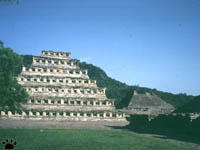
Piramide de los Nichos & Estructura 4, El Tajin. |
In addition to its unique architecture, El Tajin
is a good place to see los voladores, an ancient Totonac ritual of inviting
rain from the sky. Once very dangerous, it still requires some nerve. |

Piramide de los Nichos, El Tajin, Veracruz. |

The pole is 30 m/
100' tall. |
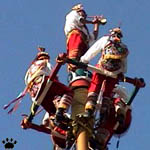
At first, the four voladores just
spin around at the top of the pole. |
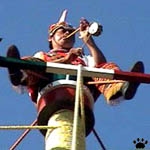
The leader plays a sacred song, using
a flute and a tiny drum. |
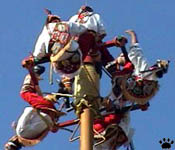
Then, the four fall back, and hang heads-
down on ropes, still spinning. |
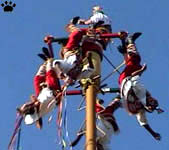
Originally, the ropes were made of vines,
and people often died when they broke.
|
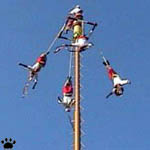
As the ropes slowly unwind, each
voladore makes 18 circles in the air. |

18x4=52, a sacred number in ancient
Mesoamerican cultures. |

Finally,
the landing. |
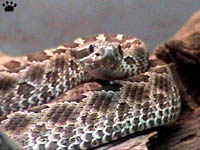
Massasauga (Sisturus catenatus), El Cielo
Biosphere Reserve, Tamaulipas. |
There is, of course, much more to see in Mexico
than any website could tell. May be it's time to turn off your computer and drive
there yourself, fellow American? It's very easy: just take any freeway south... |
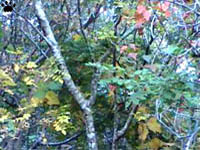
These are not fall colors - it's the dry season
in the forests of Nayarit. |
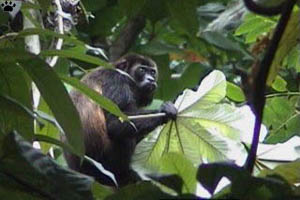
Mantled howler (Alouatta palliata), Villa Luz, Tabasco.
Back to Part 2
Home
|